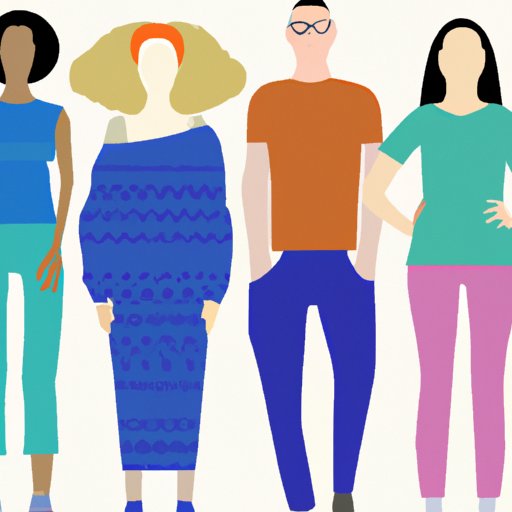Introduction
Fashion is often thought of as a form of personal expression. It is a way to showcase our individual style, tastes, values, and beliefs. But fashion is so much more than just an individual statement. It has the power to influence and shape cultures, societies, and even entire civilizations. From the earliest days of humanity, clothing has been used to differentiate between groups of people and express certain values or ideas.

Examining the Role of Fashion in Society and its Impact on Cultural Identity
Fashion plays an important role in establishing and expressing our cultural identity. The clothes we wear are often seen as a reflection of who we are, where we come from, and what we believe in. By wearing certain clothing and accessories, we can express our values and beliefs, and even create a sense of belonging within a particular group or community.
For example, traditional garments such as the sari in India, the kimono in Japan, and the dirndl in Germany all have deep cultural significance. These garments are often worn for religious ceremonies and special occasions, and they are seen as a way to honor and celebrate a person’s heritage. Similarly, traditional clothing can also be used to distinguish between different social classes. In many cultures, wealthy individuals are associated with more expensive and elaborate clothing, while those from lower socioeconomic backgrounds tend to wear simpler, more practical garments.

Exploring How Fashion Influences Social Interaction and Expression
Fashion can also be used as a form of self-expression. Through fashion, we can make a statement about ourselves and our values. We can choose to dress in a way that reflects our personality, interests, and beliefs. For example, punk fashion can be seen as a form of rebellion against mainstream society, while gothic fashion may express a darker side of one’s personality.
In addition, fashion can also affect the way we interact with others. Our clothing choices can influence the way people perceive us and how we are treated by those around us. For example, dressing in a professional manner can help to create a more favorable impression in business settings, while dressing in a more casual manner can help to create a more relaxed atmosphere in social situations.
Investigating How Fashion Can Reflect Political and Economic Trends
Fashion can also be used to demonstrate political and economic power. Throughout history, certain garments have been used to signify status and wealth. For example, in ancient Rome, only the wealthiest citizens were allowed to wear purple robes. In Medieval Europe, sumptuary laws were used to restrict the types of clothing certain individuals were allowed to wear based on their class or social rank.
In modern times, fashion can still be used to show political allegiance. For example, supporters of certain political parties may choose to wear clothing that expresses their views. Furthermore, fashion can also be used to influence public opinion. Companies and organizations often use fashion to promote their products or services.
Analyzing the Influence of Fashion on Representations of Gender, Race, and Age
Fashion can also be used to represent and reinforce certain gender roles. In many cultures, there are specific types of clothing that are traditionally associated with men and women. For example, in Western culture, dresses and skirts are often seen as feminine garments, while trousers are seen as masculine. Similarly, fashion can also be used to represent race and age. Certain styles of clothing may be associated with certain ethnicities or age groups.

Investigating the Relationship Between Fashion and Popular Culture
Finally, it is important to consider the relationship between fashion and popular culture. Popular culture influences the types of clothing and accessories that are considered fashionable at any given time. Trends in music, film, television, and other forms of media can shape our fashion choices. For example, the punk movement of the 1970s was heavily influenced by the punk rock scene, while the hip hop culture of the 1990s was heavily influenced by rap music.
Similarly, fashion can also influence popular culture. Many popular musicians, actors, and other celebrities are known for their unique fashion sense, and their fashion choices often become popular trends that are followed by their fans.
Conclusion
Fashion is an important part of culture and society. It can be used to express our beliefs, values, and identities, as well as to make a statement, influence social interactions, and reflect political and economic trends. Fashion can also be used to represent gender, race, and age, and it can be shaped by popular culture. As such, it is clear that fashion plays an important role in shaping and reflecting our culture.
Further research into this topic could explore the role of fashion in other cultures, as well as investigating how fashion can be used to challenge existing social norms and conventions.
(Note: Is this article not meeting your expectations? Do you have knowledge or insights to share? Unlock new opportunities and expand your reach by joining our authors team. Click Registration to join us and share your expertise with our readers.)
